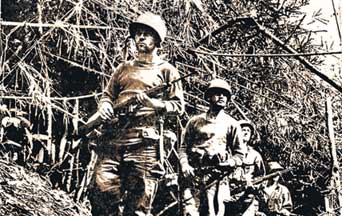
Forgotten campaign, forgotten veterans
Sunday Times, Nov 5 2006: http://www.sundaytimes.lk/061105/Plus/pls1.html
In this three-part series for Remembrance Day, Sergei De Silva Ranasinghe looks at the Burma Campaign (1941-1945) of World War II and traces the role of the Ceylon volunteers who fought at the front
It is often overlooked that the internecine Burma Campaign was for the British Army and its auxiliary forces, the longest campaign throughout the Second World War, starting from December 11, 1941 and ending on June 15, 1945. The intensity of the fighting can be gauged by the casualties suffered by both sides, with 14,326 Allied troops killed and 73,909 wounded; and among the Japanese an estimated 185,149 fatalities.
 |
| Allied soldiers in Burma during the WWII. |
Due to little public recognition received in the media and the protracted nature of the campaign which extended well past VE Day - May 8, 1945, the British/Indian Army in Burma was termed the ‘Forgotten Army’. As one officer described it, he had the, “…strong feeling that they are taking part in a forgotten campaign in which no one in authority is taking any real interest”.
During the early stages, up to early 1942, few people in Sri Lanka, then Ceylon, demonstrated an awareness of the impending strategic consequences of the Japanese invasion of Burma. Only in April, 1942, did the full reality of war come home to the people of Ceylon, when the Imperial Japanese Navy assaulted Colombo and Trincomalee by air and mauled segments of the hastily assembled British Eastern Fleet off Ceylon.Popularly, the Burma Campaign is often better known for the infamous treatment of European Prisoners of War (POWs) on the Burma-Thai railway, which received widespread coverage through the award winning film, The Bridge on the River Kwai (1957), which incidentally was itself filmed in Ceylon.
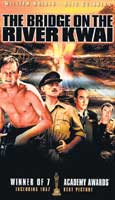 |
| A poster of the film The Bridge on the River Kwai, a movie on the Burma Campaign shot in Sri Lanka. |
At the time, the film was a huge undertaking, the bridge alone needing, as the late Noel Crusz who liaised with director David Lean, maintained in a recent interview: “Local labour, carpenters and craftsmen from Kitulgala saw 1,500 trees cut down and dragged to the site by 48 elephants … It was the largest film set built at that time, even surpassing Cecil B. de Mille’s Gates of Tanis in ‘The Ten Commandments. There were many fair-skinned Ceylonese Burghers: planters, merchants, engineers, willing to be extras. In fact 37 nationalities were among the extras, and some had fought in World War II.”
Considering Ceylon’s proximity to Burma, for years I was deeply intrigued to ascertain whether Ceylon, in any way contributed to the Burma Campaign. In recent times I was fortunate enough to find rare details alluding to the participation of Ceylon volunteers to the much vaunted Burma Campaign.
After undertaking years of extensive field research and conducting numerous interviews with veterans, I have finally gathered the biographical details and stories of several Ceylon volunteers who served in the forgotten Burma campaign, which commenced 64 years ago.
Enter the Ceylon volunteers
It presently remains obscure how many Ceylon volunteers served in the Burma Campaign, although there are fleeting indications that suggest the manpower contribution was between 100-200 volunteers.
However, I am aware that Ceylon’s volunteers formed two distinct ethnographic categories, namely, British and Ceylonese – the British mainly from the exclusively European, Ceylon Planters’ Rifle Corps (CPRC) and the Ceylonese from units of the Ceylon Defence Force (CDF) and the Ceylon Royal Naval Volunteer Reserve (CRNVR).
The British element consisted of two types; those born and raised in Ceylon; and those who settled in Ceylon for mercantile or other reasons. Both types joined the all European CPRC, a prominent unit of the CDF which was open to all European males of military age in Ceylon. An appropriate personification of this is exemplified by CPRC volunteer, Major Philip Grimwood, as stated by his relative: “Prior to World War Two, Philip was a Tea Taster in London and was then employed by Attampettia Estate, Bandarawela, Ceylon as a Tea Planter, joining the Ceylon Planters Rifles’ Corps in 1939. He was also the SD in charge of the Napier Division of Rookatenne Estate.
“With the outbreak of World War Two, he was involved with Garrison Duty in Ceylon with the CPRC. On May 7, 1942, Philip was granted an Emergency Commission into the 4/10th Gurkha Rifles. From January to May 1942, he attended the Officers Training School at Belgaum, India and was subsequently deployed at Imphal with the 4/10th Gurkhas.
The 4/10th GR War Diary entry for November 4, 1943 states: ‘Lt Grimwood and Rfm Budhiman Limbu entered Burma for attachment to 3/1 GR, being first men of 4/10th GR to enter Burma’.”
He subsequently served with the 3/4th Gurkha Rifles, as a Lieutenant attached to 40th Column in the Second Chindit Campaign. Later, he served with the Office of Strategic Services (OSS), Detachment 101 and Special Operations Executive (SOE), Z Force. Upon demobilisation at the end of the war, Major Philip Grimwood returned to Ceylon to continue his career in the tea industry. At the time, European males of military age in Ceylon were generally affiliated to the CPRC. In much the same circumstances as the First World War, throughout the Second World War, the CPRC served as valuable officer reinforcements and is estimated to have provided over 700 volunteers commissioned in the British and auxiliary armies, mainly enlisting or obtaining transfers on an individual basis. Notwithstanding, between August, 1940 and July, 1942, the CPRC dispatched six contingents amounting to 172 soldiers as officer reinforcements to the Officer Training School at Belgaum, India, and they were given postings in British/Indian Army units. According to one unpublished and incomplete list, the CPRC had at least 39 of their volunteers in Gurkha units, some of whom are highly likely to have served in Burma.
Perhaps there are many similar stories to be told about the hundreds of CPRC volunteers who served in India but that is not the objective of this article. Of the CDF units, the Ceylon Light Infantry (CLI) appears to have been where the trickle of Ceylonese volunteers originated. These participants included: Gerry Van Reyk of the 2nd battalion CLI, (who according to Lieutenant General Denis Perera served in Burma, although no records have been located); P.D. Pelpola; S.D. Ratwatte; A.R. Udugama and B.R. Kriekenbeek, who all served as military observers.
It is a matter of regret that I could not locate any substantive details on P.D. Pelpola, S.D. Ratwatte and A.R. Udugama other than their war service records.
Volunteers from outside the CDF included Rex de Silva, Bonaventure Schofield and 17 known personnel from the CRNVR. As such, the largest contribution of manpower to the Burma Campaign came from the CRNVR. As will be established, the unassuming Ceylonese contribution to this forgotten theatre, merits deference.
Peter Donald Pelpola
 |
The late Major P.D. Pelpola served in both World Wars in frontline theatres receiving many decorations to his name, including the War Medal, Defence Medal and the Burma Star for service in the Second World War and appears to have been the oldest Ceylonese volunteer to serve in Burma. Due to his rank as Major and his impressive military background, notably in the First World War where he served with the Legion of Frontiersmen in German East Africa campaigning against General Von Lettow-Vorbeck, it is quite likely that he held a position of responsibility.
According to his service records, while he was affiliated to the 2nd battalion, CLI, he volunteered to serve in Burma for a short tour. He was sent to India for further training on December 16, 1943 and was subsequently attached to the 161st Indian Infantry Brigade, in the Arakan, from January 1, 1944, to January 27, 1944.
Sooriyaratne Douglas Ratwatte
 |
The late Colonel S.D. Ratwatte joined the CLI in 1938 as a 2nd Lieutenant and when war started, he was posted to the 1st and 5th battalions, CLI. In 1942, he volunteered to serve in Burma. After initial training, he was attached to the 14/15th Punjabis, in the Arakan, where he led a company. In the post-independence Ceylon Army, S.D. Ratwatte held several senior positions in the Ceylon Volunteer Force, later the Sri Lanka Army Volunteer Force, notably as the first Commanding Officer of the 2nd (V) Sinha Regiment, retiring at the rank of Colonel.
Alexander Richard Udugama
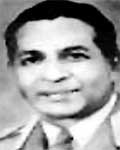 |
A.R. Udugama received a commission in the CLI as a 2nd Lieutenant in 1940 and was posted to the 1st, 3rd and 4th Battalions respectively. According to the excellent research conducted by retired Major General H.V. Athukorale: “He underwent numerous infantry courses [sic] in Ceylon and India, and was promoted to the rank of Captain on 1st January 1943. In November 1943, he was selected for attachment to the 14th Army in the operational areas of Burma. During this period of attachment, he served [sic] with the 7/2nd Punjab Regiment in the Arakan area, on the eastern side of Mayu Range. For service during the Second World War he was awarded the Burma Star, the Defence Medal and the War Medal.”
Mervyn Rex de Silva
Winner of the prestigious Lord Leverhume Aviation Scholarship, the late Rex de Silva from St. Peter’s College, Colombo, was one of several dozen Ceylonese volunteers who joined the Royal Air Force Volunteer Reserve in the Second World War and was amongst the first Ceylonese to experience frontline aerial combat in the war. He received his training in England and was posted to 504th Squadron, (Spitfires VB) at Ibsley and Redhill where his squadron escorted Marauders over German occupied ‘Fortress Europe’.
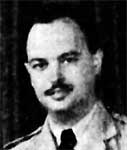 |
After a lengthy period of service in Europe, he had the honour of being posted to Ceylon in April, 1944, with the 17th Squadron, at Minneriya in defence of the ‘Trincomalee Fortress Area’. On November 19th, 1944, the 17th Squadron relocated its operational base to the Imphal valley, where air support was rendered to the allied ground offensives on Kalewa and Taukyan. In his diary, Rex summed up the events: “December 19th. Spitfire VIII. Beat Up Taukyan. Just a show for the Colonel’s benefit!!! December 19th. Patrol. Kalewa Bridgehead again. December 20th. To Sapam. And Gentlemen! Kalewa Once Again!!” Rex ended the war as a Flight Sergeant.
Brian Randall Kriekenbeek
Now an elderly gentlemen of 83, yet vibrant and alert, Brian Kriekenbeek recalled for the first time, during his telephone conversations with me, his memories of over 64 years. When war began, Brian felt assured of his motivation to fight: “I accepted the fact the British were occupiers, and felt the Empire was guarding Ceylon from the Japanese.” On completing his schooling at Royal College and turning 18, he volunteered to join the Ceylon Defence Force (CDF) and was accepted for officer cadet training at Diyatalawa. In December, 1942, after finishing a six month basic training course, he obtained a commission as a Second Lieutenant in B Company, 2nd Battalion, CLI.
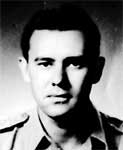 |
In November, 1943, he volunteered to serve at the Burma front. Within days of selection, he entrained from Colombo to Talaimannar and embarked on a ferry to Dhanushkodi, the closest proximity from Talaimannar to Southern India on the Rameswaram coast. On January 1st, 1944, he was attached as reinforcement to the 114th Indian Infantry Brigade in the Arakan and posted to D Company, 4/5th Gurkha Rifles, as a Second Lieutenant. Brian’s tour with the 4/5th Gurkha Rifles was an outstanding experience. In his short three-week stint he was accepted by the other ranks and officers of the battalion. Ethnically, the unit’s composition was typical of the British-Indian Army of that time, mostly British officers and Indian other ranks.
His first experience of patrolling through the jungle was uneventful. However, his experiences soon changed. As he sardonically recalled, his first combat experience was: “Quite frightening because no one had shot at me before”. However, on his second dusk patrol they stumbled on to a Japanese platoon near a paddy field. Immediately both patrols began firing at each other from a distance of about 200 yards. The loud clatter and confusion of rifle and sub-machine guns firing went on for several minutes before both patrols hastily withdrew into the jungle – as he remembers, there were no likely casualties in the skirmish. Out of the six patrols with the 4/5th Gurkha Rifles, four made contact with the Japanese.
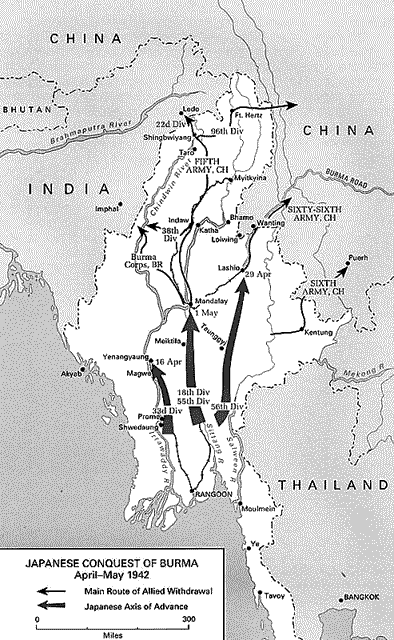
At that time, due to the static nature of their portion of the front, they had simple orders to collate field intelligence on Japanese positions, movement and numbers. As Brian said: “I conducted all my patrols at night, scouting for Japanese positions, which was pretty grim work. Night patrols were normally conducted after dinner, around 7 pm, and usually lasted several hours. We tended to stay away from the jungle tracks as they were prone to ambushes. The ‘No Man’s Land’ area we operated in was normally between three quarters to a mile in distance. At night we could not see, so we navigated with a hand-held compass which was difficult. When we encountered Japanese patrols it was always nerve wracking and confusing and we were not quite sure where they were, so we fired wildly in their direction. Once contact was made we would either drop flat on the ground or take cover and frantically scan for enemy silhouettes or muzzle flashes. If we spotted them we fired our weapons and threw grenades. The duration of these skirmish actions lasted sometimes for up to 15 minutes. Quite often contact was made out of the blue with the Japanese patrols.”
Through his encounters and experiences, he had developed an ungrudging respect for the Gurkhas he served with. “It was a brotherhood. They treated me in an excellent manner. The Gurkhas were so special, it was like working with military machines.”
Once his brief tour with the Gurkhas was over, he was posted to another unit on the Burma front for an even shorter tour as a 2nd Lieutenant in the all British composed, 1st Somerset Light Infantry, better known as the ‘SomLI’.
His posting was with C Company, 1st Somerset Light Infantry, which was attached to the 7th Division’s 33rd Indian Infantry Brigade. His duties were identical to his experience with the Gurkhas, taking part in three uneventful night patrols with no sign of the Japanese. As destiny would have it, Brian’s short two-week tour of duty with the SomLI was to be a starkly different experience. He remarks rather indignantly: “When they found out where I originated from, there was a definite change in their attitude towards me. They had very ill-informed and negative views of Ceylon and its people to the point of being condescending and just bloody rude. They didn’t like that I was an officer, didn’t respect my commission and displayed irritation when saluting me!”
Once his five-week tour of Burma ended, he was ordered back to Ceylon in February 1944 and rejoined the 2nd battalion, CLI at China Bay, Trincomalee where he was promoted to the rank of Lieutenant.
Soon after, he attended an advanced infantry training course for NCOs and junior officers at the ‘Battle School’, near Weliveriya. Subsequently, he was sent to India to attend the Jungle Warfare School, at Shimoga, in January, 1945, for one month, before rejoining the CLI in February, 1945. In mid 1945, he led a group of 10 soldiers from his battalion on a special mission, escorting 26 interned Japanese POWs to India. As he recalled, “They were just poor harmless bastards who were captured probably from the merchant navy.” The escort party travelled by train from Colombo to Talaimannar, and the group was ferried to Dhanushkodi. Once in India, they travelled by train all the way to the Red Fort, Delhi, where the POWs were transferred. Brian affirms that by the end of the war the CLI furnished guards as POW escorts for at least 6-8 missions, between Ceylon and India.
Demobbed in mid 1946 he was awarded the Burma Star and the War Medal. Subsequently in 1947, he signed up as a 2nd Lieutenant in the British Army, General List Infantry (Ceylon Section) and agreed to serve with the 1st battalion, Ceylon Corps of Military Police (CCMP) that was deployed in Malaya from August, 1947, to June, 1949, where he was promoted to the rank of Captain. After Malaya, Brian returned to Ceylon and in 1949 migrated to Australia.
Surviving amidst dying men and muddy swamps
Sunday Times Nov 12 2006
~ Remembrance Day 2006. In this the second in his three-part series on the forgotten heroes of the Burma Campaign of World War 11, Sergei DeSilva Ranasinghe traces the exploits of one intrepid Ceylonese volunteer, Bonaventure Schofield
Bon Schofield was born in Ceylon in 1922 to a Burgher planting family of four boys and two girls. He attended school at St. Joseph’s College, Maradana, but left school when he was 17 years old to start a career as a tea planter with his father’s up country plantation at Talawakelle.
When the Second World War began, Bon and his three brothers Joe, Paddy and Charles were very keen to enlist to fight overseas, which he says was spurred by his family tradition of military service in the British Army. In November, 1941, Bon, who was then 19, and his three brothers volunteered to join the British Army, affirming: “I was fighting to protect Ceylon, my mother country.”
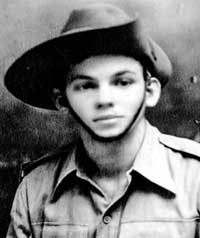 |
|
Bonaventure Schofield |
Once enlisted, they travelled by train to Talaimannar and embarked on a ferry to Dhanushkodi, then once again embarked on another train to Wellington, where they all joined their new unit, the 2nd Worcestershire Regiment. In February, 1943, Bon was drafted as reinforcement for the 1st Royal Welsh Fusiliers (RWF), 6th Independent Brigade, 2nd British Division, a unit and formation he would remain with until February 25, 1945.
As reinforcement Bon was sent to Chittagong and then on towards Donbaik, to participate in a major offensive thrust against the Japanese in the Arakan, as he explained: “The 1st battalion RWF were in Burma. I joined them with 224 others on the 22nd February, 1943 as reinforcements. The battalion had been in action, and had suffered heavy casualties in Burma. I was posted as a Rifleman to B Company, 12 Platoon.”
After months of inactivity at the frontline, the British Army launched a divisional sized offensive into the Arakan, with the aim of capturing the strategically important Mayu Peninsula and air field at Akyab.
The First Arakan Campaign extended from December, 1942 to May, 1943. The British advance at Donbaik met fierce and well fortified Japanese resistance, which in counter-attack after counter-attack proved impossible to dislodge. Practically upon arrival Bon was thrown into action and received his ‘baptism of fire’ in a skirmish action against Japanese snipers. The 1st RWF sustained heavy casualties around Donbaik and was forced to withdraw by night, along with the rest of the division, to the village of Indin, 20 miles away.
Parallel to these events, the Japanese 112th Infantry Regiment had outflanked the division’s exposed left flank in a surprise attack, overrunning several units including the 6th Brigade headquarters. The 1st RWF was immediately involved in heavy fighting when it arrived at Indin. Heavy fighting continued all day and a dire situation developed for the entire 14th Indian Division, as Bon put it: “We suffered more casualties and retreated at night along the beach. We fought our way back to India over mountains, rivers and jungle.”
After recuperating for 39 days in hospitals around Northern India, Bon was rewarded with three weeks leave in Ceylon. Afterwards, he rejoined his battalion in June, 1943, at Ahmednagar, 117km northeast of Pune. The 1st RWF underwent more jungle training and a refit until March, 1944, when it was transferred to Assam to relieve the siege of the desperate British garrison at Kohima.
The over-ambitious Japanese offensive code named Operation U-Go, began on March 7, 1944, with the primary objective of capturing Imphal, the capital of the hill state of Manipur Province and Kohima, with the principal intention of invading British-India’s eastern periphery, Assam.
The Japanese were keen to capture the massive supply dumps that existed at Imphal and Kohima, which they heavily relied upon to sustain their grand offensive plans. Burma, was considered the gateway into India, where the Japanese believed a general insurrection against the British Raj would take place once their troops along with Subas Chandra Bose’s, Indian National Army, had established a foothold in Assam, within reach of Calcutta. The Japanese began their siege on April 5, 1944, which forced the British to supply the garrison by air. The desperate battle received accolades from the Supreme Allied Commander, South East Asia Command, Lord Louis Mountbatten, who described it as "probably one of the greatest battles in history... the British/Indian Thermopylae.”
It was in this setting that Bon Schofield encountered fanatical resistance from Japanese soldiers and his hardest fighting of the entire campaign, which he vividly described: “In March, 1944, we were rushed to Kohima in Assam, the Japs had already captured most of the Kohima ridges. Our battalion reached Dimapur from Ahmednagar on April 12, with a full strength of 35 officers and 869 other ranks. The next day we advanced 18 miles down the road digging in and sent out recce patrols. My platoon reached Zubsa at Mile Stone 38. The battalion then positioned itself covering the road to the south of Zubsa, with a small force in the village itself.” On April 18, after much fighting the British led forces finally lifted the siege at Kohima, but considerable fighting still lay ahead.
The next day his unit was involved in heavy fighting, as he stated: “From then on we were in constant contact with the enemy and many hand-to-hand battles and we occupied Garrison Hill.”
Although the siege was lifted, the Japanese still held the forward positions they had taken around Kohima and fiercely defended it. As Bon testified, a grim war of attrition ensued: “On April 29th, the battalion was brought up in carriers along the road still under fire by enemy snipers, and relieved the Durham Light Infantry on Garrison Hill. B & C companies came under fire while crawling through the shallow muddy communication trenches to take over the forward dug outs and fox holes. The most lasting impression of all was caused by the stench of decaying bodies, half buried or lying in the open between the lines. The fighting in Kohima was bloody hand to hand fighting with no quarter asked and no quarter given. The few yards of no man’s land were strewn with the dead of both sides. In some of the trenches, rotting bodies of Japanese were used as a protective parapet. But mercifully lime was available to make the task less distasteful. Space was so limited that dug-outs, latrines, cook houses and graves were all close together. When the rains came it poured in buckets and the trenches filled up with water. We were so tired, that we went to sleep with the water up to our chest. It was almost impossible to dig anywhere without uncovering a latrine or a grave. Flies swarmed everywhere and men were wretched as they dug in. The stench hung in the air and permeated ones clothes and hair. The ground everywhere was ploughed with shell fire and it stank.
“I will never forget C Company going in to attack Kuki’s Piquet. Coming out of their trenches, they reached a jeep track near the top of hill, when the Japs opened up with their machine guns killing everyone in their sights. The following morning was our turn. We went through A Company lines and attacked the Japs. Almost immediately, our Company Commander, Platoon Commander, and Sergeant were wounded by sniper fire. We all dropped where we were, out of line of the sniper, but this was not for long. We were ordered to move forward. I’d only just started when a grenade came over.
“I got down quickly and saw Bren Gunner, Fusilier Ron Jones running not ten feet in front of me, I yelled out ‘Get down, Get down!’, but tragically the grenade exploded with Private Jones crumpled up on the ground in front of me on the slope. Fusilier Morris and I crawled up to Fusilier Jones. There was not a thing we could do, he was dead. Planes came over parachuting our rations, when a huge basket of rations came with a bang dropping close to both of us. The mortars then dropped some smoke bombs and we pulled out back to our lines.”
By June, 1944, the Japanese had been forced out of many positions around Kohima. His unit was subsequently involved in combat with the rear guard elements of the retreating Japanese Army. “After 4 months rest and with reinforcement we started after the Japs again, and marched about 1,000 miles over mountains and jungle. We were in the Kabaw Valley.”
On February 24, 1945, his battalion prepared for a renewed advance, in a risky night operation to capture a key island in the middle of the massive Irrawaddy River. The objective was a small island in the middle of the river.
His section, almost immediately, was hit by Japanese machine gun fire from across the river. When disembarking near the shoreline, Bon’s boat was hit and he sustained a serious leg wound. As he recalled, his ‘Mae West’ life jacket prevented him from drowning, while he sat helpless in the water up to his armpits for hours: “I managed to drop my ammunition vest off to stop the weight pulling me down. I just sat there and hoped for the best. I was many hours in the water with an open gash in my thigh. I could feel things eating at the open wound. I was so thirsty I drank pints of muddy river water.”
Hours later, he was rescued by two unknown British soldiers in a motor boat: “They threw me into the boat and took me back across. I never knew who they were.”
For Bon, the war was over.
He was taken to a field hospital and then transported to India for treatment
spending 10 months in hospital, and was bedridden for seven of them. After
recovery, he was discharged and returned to Ceylon on December 17, 1945.
After the war Bon migrated to Australia in 1949, where he has since lived. Bon
was awarded the Burma Star, War Medal, 39-45 Star and Defence Medal.
CRNVR’s role in the allied reconquest of Burma
Sunday Times Nov 19, 2006
Concluding his series on the Ceylon volunteers in the Burma Campaign of World War 11, Sergei DeSilva-Ranasinghe reports on the action off the coast
Outside the participation of individual Ceylon volunteers in the 14th Army, the presence of the CRNVR off the coast of Burma is another historic and intriguing case of the overseas deployment of Ceylonese servicemen during the Burma Campaign.
In early 1945, while the allied reconquest of
Burma was steadily progressing and the Japanese Army was in full retreat,
the South East Asia Command (SEAC), Supreme Allied Commander, Lord Louis
Mountbatten and his staff planned to retake the Arakan and Rangoon by land
and seaborne offensives. Due to the general shortage of ships available, the
CRNVR’s Commander, Captain Beauchamp, offered resources, providing two Motor
Fishing Vessels (MFVs) with crews to logistically assist the allied
offensives.
The special mission consisted of two ships, MFVs 185 and 186, inclusive of
17 crew members. The crew on each ship was as follows: MFV 185 - Lieutenant
D.V. Hunter; Sub-Lieutenant Ivan de Livera; Leading/Seaman S.A. Fernando;
Leading/Seaman A.A. Fernando; Able Seaman Ponnuchamy; Leading Stoker
Attapattu; Stoker N. Abeydeera; Stoker Tony Fernando and Yeoman of Signals
E.P. Wickremasinghe. MFV 186: Lieutenant Raja Proctor; Sub-Lieutenant George
Ekanayake; Leading-Seaman F. Sabamalai; Leading-Seaman G.A. Fernando; Able
Seaman S.V. Mariam; Able Seaman Weerasingham; Stoker Piyasena; Stoker
Saranelis.
|
|
|
Rear Admiral D.V. Hunter |
Fortunately, Lieutenant D.V. Hunter, kept a personal account of his mission, entitled ‘A Passage to Burma’, which was published in Somasiri Devendra’s book, A History of the Navy in Sri Lanka: The Ceylon Royal Naval Volunteer Reserve (1937-1950), (Colombo: Sri Lanka Navy, 1995), pp. 37-42: “We were ready to proceed in the stipulated week and had made contact with the Commanding Officer of the ML that would escort us, and planned our movement. We were to go through Pambam Pass, the passage between India and Ceylon at Adam's Bridge and stop at Madras and Vizagapatnam before crossing the Bay of Bengal to Akyab. We reported to the Chief of Staff who took us into the ‘Old man’, Capt. Beauchamp, the then boss of our outfit. ‘Well, Proctor and Hunter, here's something exciting for you to do. I suppose you know that at this moment the Jap front line is 5 miles from Akyab. They've just been thrown out, but haven't gone far’. We knew that, of course, and also that they were on the run; but that did not prevent my heart from missing a beat at what 5 miles meant. I made a quick calculation - Fort to Bambalapitiya. I swallowed hard and looked sideways at Proctor. The .... was grinning. He was enjoying the prospect of being shot at! I smiled weakly and tried to look brave.
"‘Any questions or problems, now before you take off?’ said the Big Boss. There was only one thing troubling us and that was that we had no independent communications and if we got separated in the Bay we'd be in real trouble. ‘Well, don't bloody well get separated then’ was the answer to that one when we pointed that out, and there was nothing to say but ‘Aye, aye, sir’; and then he softened and said ‘Don't worry, we'll find you if you get lost. Well, good luck! And take care of yourselves’, were his passing words and we knew he meant it. We were like one big family then and we knew that he was worried that he was sending some of his ‘sons’ into danger. But he also knew there was a war on!
“The passage through Pamban was uneventful but when 100 miles from Madras my ERA reported on the bridge one morning and said we had to stop engines. There was something wrong – a knock – in the engine, he said, and we must stop, open up and inspect. After signalling 1285 what we had to do, all ships stopped and waited for us. In half – an hour the ERA was back and he said one word ‘Kaput’, ‘No go, Chief?’ said I. ‘No go, sir’, said he. Towing was the answer and 1285 took us for a few hours and the HM Indian ship (as they were called then) Cuttack towed us the rest of the way to Madras. We were stuck for a week under repairs and the escort and Proctor’s ship had to leave me and proceeded on their own.
“Repairs completed, I was sailed to Vizagapatnam where I was to pick up a new escort to cross the bay but after re-fuelling and topping up with water and food the XDO (this was the short title for ‘Extended Duties Officer’ and I don’t know why ‘Extended’ but anyway he now appeared to be, full!) sent for me and said he had no escort and could I make the last leg of my passage alone? At that time I had one hell of an opinion of myself as a navigator and my reply was that it would be no problem. I conveniently forgot about the communications. There is a saying that to be a good captain one must also be lucky and I was certainly lucky on that occasion. Calm seas, clear days and nights, and the enemy off the immediate sea far away. It was a picnic and we made our landfall on the dot. Proctor came to me in 186 and showed me where he was parked and I secured alongside him.
“When we were on talking terms again after securing, I asked him what the score was. ‘Just fiddling around,’ said he, ‘running ammunition and stores to warships and river craft, from the ammunition and stores ships over there.’ ‘Where are the Japs?’ I asked. ‘Not far. You’ll hear them soon enough tonight when they pass over here to bomb the air-field, but you won’t see them.’ And there was his silly grin again. ‘What’s funny?’ said I. ‘This is the life’ said he, ‘and I am going to volunteer to go up the river.’ He was a senior and if he went I would have to follow. The bloody idiot had forgotten the old rule – never volunteer: it will come soon enough. ‘We can see some action. Nothing’s happening here’ – and the enemy only five miles away! ‘Better report yourself to the NOIC. He must be expecting you,’ said Proctor. And this didn’t take long. It was as Proctor advised, maid-of-all-work in the harbour. That night we heard heavy guns firing eastward and knew the fight had commenced. They seemed to prefer to fight in the dark and expected you to sleep by day. As prophesized, the bombers passed over that night for their usual strafing of the air-field and we opened fire with our main armament – 4 in no. 9mm Lanchesters! Couldn’t see them, of course, but they must have been close overhead as the roar of their passing was deafening. ‘Don’t shoot, sir,’ pleaded a seaman at my elbow, ‘they’ll see you and drop something.’ ‘Go to hell,’ I retorted, ‘how do you think I am going to expend this ammo otherwise? We are not going up the river-unless somebody volunteers’ – and I felt the butterflies fluttering madly about in my innards as I thought of what passed between Proctor and me earlier.
“Three months were we in Akyab. They didn’t send us up the river although Proctor volunteered, as promised. They reckoned, quite rightly, that we’d be sitting ducks and wanted us in one piece to work in the harbour. We saw wounded prisoners coming in daily and had to help out from time to time. Air raids at dawn and dusk became routine even though the Japs were soon pushed far into Burma. One of the finest fireworks displays I have seen took place when they hit our ammunition ship in harbour during a dawn raid. One moment she was there and the next she was gone forever. Everything inside her went up and she herself went the other way. The concussion was terrific and our little ships were bobbing about for an hour afterwards. I gulped when I remembered that I was to have been alongside her in an hour to unload ammo. Shortly after this I hit a marker buoy which was not ‘watching’ properly and nearly sank before I put my ship on the beach. A damaged stern gland due to the blow let the water in. This was soon plugged and 186 towed me alongside a salvage vessel and we were pumped dry in ten minutes. However, the accident placed 185 ‘hors de combat’ and we were taken into an inlet of the river near by and beached. War receding, our usefulness had gone and the powers-that-be were not going to worry about repairing my little vessel. We were all taken off one day and returned home soon afterwards in a British warship.”
Retrospective
Clearly, the veritable contribution of Ceylon volunteers to the Burma Campaign is another outstanding example of Ceylon’s involvement in the Second World War. My research so far indicates that 24 Ceylonese served in the Burma Campaign, (17 CRNVR; 5 CLI; one RAF and one 1st RWF). Interestingly, several of Ceylon’s Burma Campaign veterans later served in the post-independence armed forces, with two particularly rising to the rank of Commander: Major General A.R. Udugama (1964-1966) of the Ceylon Army and Rear Admiral Victor Hunter (1970-1973) of the Royal Ceylon Navy.
Although it is estimated that at least 200 Ceylonese or perhaps more were awarded the Burma Star, it is more than apparent, considering the broad eligibility regulations of the Burma Star, that many servicemen had not served in Burma itself, which is an important distinction to clarify.
Indeed, these historical revelations open a new chapter in colonial Ceylon’s military history, which until now remained under-researched. As such, I am hopeful that in time, I will be able to expand on this article with new sources of historical information, to reveal further, the involvement of Ceylon’s volunteers in the Burma Campaign.
Sergei DeSilva-Ranasinghe is interested in corresponding with people who can provide any further information or assistance to his research. Email: sergeidesilva@hotmail.com or PO Box 251. Batman. Victoria. 3058. Australia